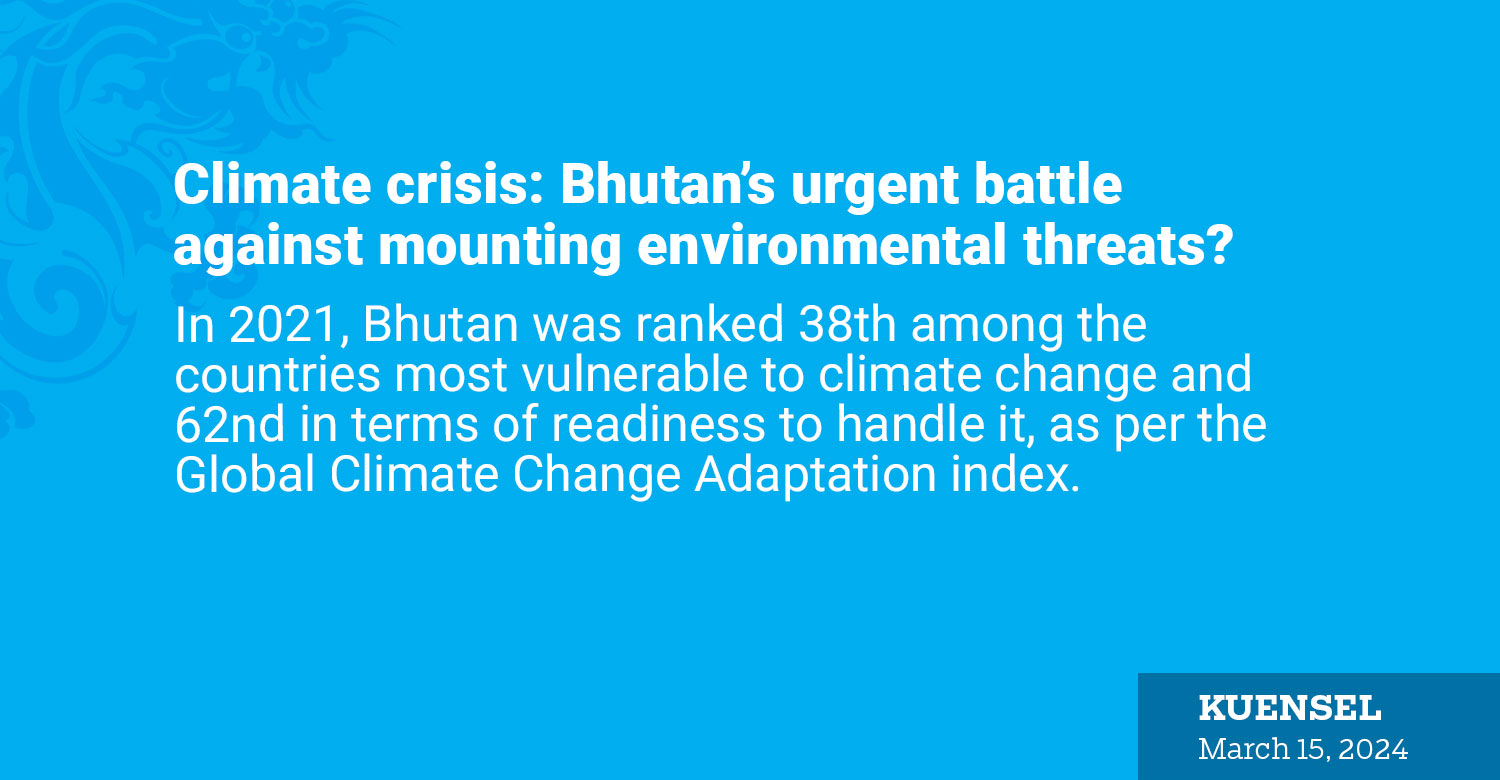Sherab Lhamo
In 2021, Bhutan was ranked 38th among the countries most vulnerable to climate change and 62nd in terms of readiness to handle it, as per the Global Climate Change Adaptation index.
This means that Bhutan has made some preparations for climate change, but there’s still more work to be done in the future.
A recent report pointed out various vulnerabilities linked to climate change, such as the Himalayas experiencing a three-fold increase in average temperature compared to the global average.
According to the Bhutan climate change tracker for 2020, it’s projected that between 2020 and 2030, temperatures will rise by 2 degrees Celsius, surpassing the Paris Agreement’s target of limiting the increase to 1.5 degrees Celsius.
The mean annual rainfall in Bhutan is expected to intensify, leading to more intense rainfall events, unpredictable rainfall patterns, and changes in the timing of the monsoon season.
According to projections under the Representative Concentration Pathway (RCP) 4.5 and 8.5 scenarios, there is anticipated to be an increase in annual rainfall. These scenarios suggest a rise of 10 to 20 percent from 2021 to 2050, and a further increase to 30 percent from 2070 to 2100.
A Representative Concentration Pathway (RCP) is a tool used by scientists to understand potential future climate changes. It doesn’t predict how people will behave, but rather it outlines different scenarios of how greenhouse gas emissions might evolve over time.
These scenarios help researchers model and predict how the Earth’s climate system could respond to different levels of greenhouse gas concentrations in the atmosphere.
Another thing to consider was the increasing danger of natural disasters because of changes in the weather. This involves risks like floods from lakes overflowing (GLOFs), landslides, earthquakes, rivers eroding, sudden floods, powerful winds, and wildfires. Bhutan has seen these kinds of events before, with GLOFs happening in 1957, 1960, 1968, and 1994. In 1994, a GLOF from Luggye Tsho sadly led to 21 deaths and a lot of land being damaged.
The report says that because Bhutan has lots of mountains and not enough detailed data about space and time, it’s hard to take steps to adapt to changes. It also warns that extreme weather is probably going to make floods worse and might even put dams at risk.
In some areas of the country, Bhutan is also seeing longer and more intense dry spells, which can lead to forest fires and smaller harvests. Additionally, during the summer, heavy monsoons often bring back-to-back floods and sudden floods.
By the year 2050, it’s expected that Bhutan’s Gross Domestic Product (GDP) might drop by 1.4 percent due to the average economic harm caused by climate change effects.
Additionally, by the year 2047, it’s predicted that over half of Bhutan’s population will live in cities, reaching 56.8 percent. This could put pressure on water supplies and managing waste. While Bhutan has done well in ensuring clean water for its people, the fast growth of cities and not managing waste properly could challenge their efforts to stay ahead in sustainability.
According to the report, the biggest contributors to greenhouse gas emissions in Bhutan are waste and emissions released from it. Together, they make up 87 percent of all greenhouse gases, with 13 percent coming just from getting rid of solid waste.
Another growing problem is plastic waste. Bhutan uses about 18,000 tonnes of plastic every year and produces around 14,000 tonnes of plastic waste annually.
Even though there have been attempts to find other options, firewood is still the main choice for cooking and heating in rural areas. This has led to Bhutan having some of the highest rates of firewood use per person in the world.
Way forward
According to the draft of the 13th Five-Year Plan (FYP) currently being reviewed, Bhutan aims to set up national weather and flood warning centres operational round the clock, improve its scientific facilities, and upgrade the National Hydromet Observation Network and Infrastructure.
Additionally, it plans to enhance Aviation Meteorological services, improve weather and climate services, and bolster early warning services for hydrological and Glacial Lake Outburst Floods (GLOF). Furthermore, the plan includes initiatives to monitor and research the cryosphere in Bhutan and to strengthen technical standards and research capabilities.
To tackle these challenges, the report offers a set of suggestions. One of them is to responsibly use the country’s natural resources by connecting conservation and protection efforts with economic growth. This involves making the most of Bhutan’s abundant natural resources to connect environmental protection with economic growth and local development.
To promote environmentally friendly production methods, it might be worth considering a carbon taxation system for businesses and industries in the future. This involves discussing the advantages and disadvantages of using fiscal incentives to encourage businesses to reduce their carbon emissions.
With air quality problems on the rise, addressing them could involve tackling pollution caused by inefficient energy consumption and the growing transportation sector.
With the urban population projected to reach 56.8 percent by 2047 and issues like waste management, waste discharge, and plastic leakage contributing to greenhouse gas emissions, the report suggests adopting the Zero Waste Bhutan initiative by 2030.
This initiative aims to improve waste prevention and management.
Additionally, it recommends creating a master plan for sustainable and emission-free urbanisation, both for the short and long term. This plan would help maintain low-carbon urbanisation and tackle the increasing environmental challenges in urban areas.
Since firewood is still the primary fuel for cooking and heating in rural areas, investing in mid-scale charcoal production within the country could offer a more efficient use of fuelwood.


